Greek mythology
| Part of a series on |
| Greek mythology |
|---|
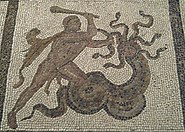 |
| Deities |
| Heroes and heroism |
| Related |
|
|
| Mythology |
|---|
Greek mythology is the body of
The Greek myths were initially propagated in an
Aside from this narrative deposit in
Greek mythology has had an extensive influence on the culture, arts, and literature of Western civilization and remains part of Western heritage and language. Poets and artists from ancient times to the present have derived inspiration from Greek mythology and have discovered contemporary significance and relevance in the themes.[4]: 43
Sources
Greek mythology is known today primarily from
Literary sources
Mythical narration plays an important role in nearly every genre of Greek literature. Nevertheless, the only general mythographical handbook to survive from Greek antiquity was the Library of Pseudo-Apollodorus. This work attempts to reconcile the contradictory tales of the poets and provides a grand summary of traditional Greek mythology and heroic legends.[7]: 1 Apollodorus of Athens lived from c. 180 BC to c. 125 BC and wrote on many of these topics. His writings may have formed the basis for the collection; however, the "Library" discusses events that occurred long after his death, hence the name Pseudo-Apollodorus.
Among the earliest literary sources are
Lyrical poets often took their subjects from myth, but their treatment became gradually less narrative and more allusive. Greek lyric poets, including Pindar, Bacchylides and Simonides, and bucolic poets such as Theocritus and Bion, relate individual mythological incidents.[9]: xii Additionally, myth was central to classical Athenian drama. The tragic playwrights Aeschylus, Sophocles, and Euripides took most of their plots from myths of the age of heroes and the Trojan War. Many of the great tragic stories (e.g. Agamemnon and his children, Oedipus, Jason, Medea, etc.) took on their classic form in these tragedies. The comic playwright Aristophanes also used myths, in The Birds and The Frogs.[8]: 8
Historians Herodotus and Diodorus Siculus, and geographers Pausanias and Strabo, who traveled throughout the Greek world and noted the stories they heard, supplied numerous local myths and legends, often giving little-known alternative versions.[9]: xii Herodotus in particular, searched the various traditions he encountered and found the historical or mythological roots in the confrontation between Greece and the East.[10]: 60 [11]: 22 Herodotus attempted to reconcile origins and the blending of differing cultural concepts.
The poetry of the
- The Roman poets Servius's commentary.
- The Greek poets of the .
- The Greek poets of the Hellenistic period: Apollonius of Rhodes, Callimachus, Pseudo-Eratosthenes, and Parthenius.
Prose writers from the same periods who make reference to myths include
Finally, several
Archaeological sources

The discovery of the Mycenaean civilization by the German amateur archaeologist Heinrich Schliemann in the nineteenth century, and the discovery of the Minoan civilization in Crete by the British archaeologist Arthur Evans in the twentieth century, helped to explain many existing questions about Homer's epics and provided archaeological evidence for many of the mythological details about gods and heroes. The evidence about myths and rituals at Mycenaean and Minoan sites is entirely monumental, as the Linear B script (an ancient form of Greek found in both Crete and mainland Greece) was used mainly to record inventories, although certain names of gods and heroes have been tentatively identified.[3]
Geometric designs on pottery of the eighth-century BC depict scenes from the Trojan cycle, as well as the adventures of Heracles.[13] These visual representations of myths are important for two reasons. Firstly, many Greek myths are attested on vases earlier than in literary sources: of the twelve labors of Heracles, for example, only the Cerberus adventure occurs in a contemporary literary text.[14] Secondly, visual sources sometimes represent myths or mythical scenes that are not attested in any extant literary source. In some cases, the first known representation of a myth in geometric art predates its first known representation in late archaic poetry, by several centuries.[5] In the Archaic (c. 750 – c. 500 BC), Classical (c. 480–323 BC), and Hellenistic (323–146 BC) periods, Homeric and various other mythological scenes appear, supplementing the existing literary evidence.[3]
Survey of mythic history
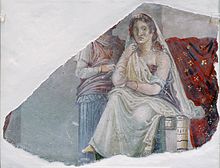
Greek mythology has changed over time to accommodate the evolution of their culture, of which mythology, both overtly and in its unspoken assumptions, is an index of the changes. In Greek mythology's surviving literary forms, as found mostly at the end of the progressive changes, it is inherently political, as Gilbert Cuthbertson (1975) has argued.[i][15]
The earlier inhabitants of the
After the middle of the Archaic period, myths about relationships between male gods and male heroes became more and more frequent, indicating the parallel development of
The achievement of epic poetry was to create story-cycles and, as a result, to develop a new sense of mythological chronology. Thus Greek mythology unfolds as a phase in the development of the world and of humans.[19]: 11 While self-contradictions in these stories make an absolute timeline impossible, an approximate chronology may be discerned. The resulting mythological "history of the world" may be divided into three or four broader periods:
- The myths of origin or age of gods (Theogonies, "births of gods"): myths about the origins of the world, the gods, and the human race.
- The age when gods and mortals mingled freely: stories of the early interactions between gods, demigods, and mortals.
- The age of heroes (heroic age), where divine activity was more limited. The last and greatest of the heroic legends is the story of the Trojan War and after (which is regarded by some researchers as a separate, fourth period).[8]: 35
While the age of gods often has been of more interest to contemporary students of myth, the Greek authors of the archaic and classical eras had a clear preference for the age of heroes, establishing a chronology and record of human accomplishments after the questions of how the world came into being were explained. For example, the heroic Iliad and Odyssey dwarfed the divine-focused Theogony and Homeric Hymns in both size and popularity. Under the influence of Homer the "hero cult" leads to a restructuring in spiritual life, expressed in the separation of the realm of the gods from the realm of the dead (heroes), of the Chthonic from the Olympian.[20]: 205 In the Works and Days, Hesiod makes use of a scheme of Four Ages of Man (or Races): Golden, Silver, Bronze, and Iron. These races or ages are separate creations of the gods, the Golden Age belonging to the reign of Cronos, the subsequent races to the creation of Zeus. The presence of evil was explained by the myth of Pandora, when all of the best of human capabilities, save hope, had been spilled out of her overturned jar.[21] In Metamorphoses, Ovid follows Hesiod's concept of the four ages.[22]
Origins of the world and the gods

"Myths of origin" or "
A motif of father-against-son conflict was repeated when Cronus was confronted by his son, Zeus. Because Cronus had betrayed his father, he feared that his offspring would do the same, and so each time Rhea gave birth, he snatched up the child and ate it. Rhea hated this and tricked him by hiding Zeus and wrapping a stone in a baby's blanket, which Cronus ate. When Zeus was full-grown, he fed Cronus a drugged drink which caused him to vomit, throwing up Rhea's other children, including Poseidon, Hades, Hestia, Demeter, and Hera, and the stone, which had been sitting in Cronus's stomach all this time. Zeus then challenged Cronus to war for the kingship of the gods. At last, with the help of the Cyclopes (whom Zeus freed from Tartarus), Zeus and his siblings were victorious, while Cronus and the Titans were hurled down to imprisonment in Tartarus.[24]
Zeus was plagued by the same concern, and after a prophecy that the offspring of his first wife, Metis, would give birth to a god "greater than he", Zeus swallowed her.[25]: 98 She was already pregnant with Athena, however, and she burst forth from his head—fully-grown and dressed for war.[25]: 108
The earliest Greek thought about poetry considered the theogonies to be the prototypical poetic genre—the prototypical mythos—and imputed almost magical powers to it.
Images existed on pottery and religious artwork that were interpreted and more likely, misinterpreted in many diverse myths and tales. A few fragments of these works survive in quotations by Neoplatonist philosophers and recently unearthed papyrus scraps. One of these scraps, the Derveni Papyrus now proves that at least in the fifth-century BC a theogonic-cosmogonic poem of Orpheus was in existence.[20]: 236 [27]: 147
The first philosophical cosmologists reacted against, or sometimes built upon, popular mythical conceptions that had existed in the Greek world for some time. Some of these popular conceptions can be gleaned from the poetry of Homer and Hesiod. In Homer, the Earth was viewed as a flat disk afloat on the river of Oceanus and overlooked by a hemispherical sky with sun, moon, and stars. The Sun (Helios) traversed the heavens as a charioteer and sailed around the Earth in a golden bowl at night. Sun, earth, heaven, rivers, and winds could be addressed in prayers and called to witness oaths. Natural fissures were popularly regarded as entrances to the subterranean house of Hades and his predecessors, home of the dead.[28]: 45 Influences from other cultures always afforded new themes.
Greek pantheon
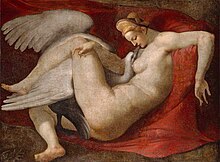
According to Classical-era mythology, after the overthrow of the Titans, the new
The gods of Greek mythology are described as having essentially corporeal but ideal bodies. According to Walter Burkert, the defining characteristic of Greek anthropomorphism is that "the Greek gods are persons, not abstractions, ideas or concepts."[20]: 182 Regardless of their underlying forms, the Ancient Greek gods have many fantastic abilities; most significantly, the gods are not affected by disease, and can be wounded only under highly unusual circumstances. The Greeks considered immortality as the distinctive characteristic of their gods; this immortality, as well as unfading youth, was insured by the constant use of nectar and ambrosia, by which the divine blood was renewed in their veins.[29]: 4
Each god descends from his or her own genealogy, pursues differing interests, has a certain area of expertise, and is governed by a unique personality; however, these descriptions arise from a multiplicity of archaic local variants, which do not always agree with one another. When these gods are called upon in poetry, prayer, or cult, they are referred to by a combination of their name and
Most gods were associated with specific aspects of life. For example,
Age of gods and mortals
"The origins of humanity [were] ascribed to various figures, including Zeus and Prometheus."[33]
Bridging the age when gods lived alone and the age when divine interference in human affairs was limited was a transitional age in which gods and mortals moved together. These were the early days of the world when the groups mingled more freely than they did later. Most of these tales were later told by Ovid's Metamorphoses and they are often divided into two thematic groups: tales of love, and tales of punishment.[8]: 38
Tales of love often involve incest, or the seduction or rape of a mortal woman by a male god, resulting in heroic offspring. The stories generally suggest that relationships between gods and mortals are something to avoid; even consenting relationships rarely have happy endings.[8]: 39 In a few cases, a female divinity mates with a mortal man, as in the Homeric Hymn to Aphrodite, where the goddess lies with Anchises to produce Aeneas.[34]
The second type (tales of punishment) involves the appropriation or invention of some important cultural artifact, as when

In another story, based on an old folktale-motif,
Heroic age
The age in which the heroes lived is known as the Heroic age.[41] The epic and genealogical poetry created cycles of stories clustered around particular heroes or events and established the family relationships between the heroes of different stories; they thus arranged the stories in sequence. According to Ken Dowden (1992), "there is even a saga effect: We can follow the fates of some families in successive generations."[19]: 11
After the rise of the hero cult, gods and heroes constitute the sacral sphere and are invoked together in oaths and prayers which are addressed to them.[20]: 205 Burkert (2002) notes that "the roster of heroes, again in contrast to the gods, is never given fixed and final form. Great gods are no longer born, but new heroes can always be raised up from the army of the dead." Another important difference between the hero cult and the cult of gods is that the hero becomes the centre of local group identity.[20]: 206
The monumental events of Heracles are regarded as the dawn of the age of heroes. To the Heroic Age are also ascribed three great events: the Argonautic expedition, the Theban Cycle, and the Trojan War.[41][42]: 340
Heracles and the Heracleidae
Some scholars believe
While his tragic end provided much material for tragedy—
Heracles also entered Etruscan and Roman mythology and cult, and the exclamation "mehercule" became as familiar to the Romans[clarification needed] as "Herakleis" was to the Greeks.[20]: 211 In Italy he was worshipped as a god of merchants and traders, although others also prayed to him for his characteristic gifts of good luck or rescue from danger.[44]
Heracles attained the highest social prestige through his appointment as official ancestor of the

Other members of this earliest generation of heroes such as Perseus, Deucalion, Theseus and Bellerophon, have many traits in common with Heracles. Like him, their exploits are solitary, fantastic and border on fairy tale, as they slay monsters such as the Chimera and Medusa. Bellerophon's adventures are commonplace types, similar to the adventures of Heracles and Theseus. Sending a hero to his presumed death is also a recurrent theme of this early heroic tradition, used in the cases of Perseus and Bellerophon.[47]
Argonauts
The only surviving Hellenistic epic, the
Although Apollonius wrote his poem in the 3rd century BC, the composition of the story of the Argonauts is earlier than Odyssey, which shows familiarity with the exploits of Jason (the wandering of Odysseus may have been partly founded on it).[51][52] In ancient times the expedition was regarded as a historical fact, an incident in the opening up of the Black Sea to Greek commerce and colonization.[51] It was also extremely popular, forming a cycle to which a number of local legends became attached. The story of Medea, in particular, caught the imagination of the tragic poets.[52]
House of Atreus and Theban Cycle
In between the Argo and the Trojan War, there was a generation known chiefly for its horrific crimes. This includes the doings of Atreus and Thyestes at Argos. Behind the myth of the house of Atreus (one of the two principal heroic dynasties with the house of Labdacus) lies the problem of the devolution of power and of the mode of accession to sovereignty. The twins Atreus and Thyestes with their descendants played the leading role in the tragedy of the devolution of power in Mycenae.[53]
The Theban Cycle deals with events associated especially with Cadmus, the city's founder, and later with the doings of Laius and Oedipus at Thebes; a series of stories that lead to the war of the Seven against Thebes and the eventual pillage of that city at the hands of the Epigoni.[7]: 317 (It is not known whether the Seven figured in early epic.) As far as Oedipus is concerned, early epic accounts seem to have him continuing to rule at Thebes after the revelation that Iokaste was his mother, and subsequently marrying a second wife who becomes the mother of his children—markedly different from the tale known to us through tragedy (e.g. Sophocles' Oedipus Rex) and later mythological accounts.[7]: 311
Trojan War and aftermath
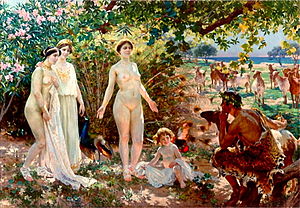
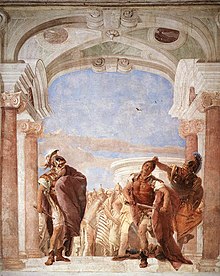
Greek mythology culminates in the Trojan War, fought between Greece and Troy, and its aftermath. In Homer's works, such as the Iliad, the chief stories have already taken shape and substance, and individual themes were elaborated later, especially in Greek drama. The Trojan War also elicited great interest in the Roman culture because of the story of Aeneas, a Trojan hero whose journey from Troy led to the founding of the city that would one day become Rome, as recounted in Virgil's Aeneid (Book II of Virgil's Aeneid contains the best-known account of the sack of Troy).[54][55] Finally there are two pseudo-chronicles written in Latin that passed under the names of Dictys Cretensis and Dares Phrygius.[56]
The
The Trojan War provided a variety of themes and became a main source of inspiration for Ancient Greek artists (e.g.
Some of the more famous heroes noted for their inclusion in the Trojan War were:
On the Trojan side:
On the Greek side:
- Ajax (there were two Ajaxes)
- Achilles
- King Agamemnon
- Menelaus
- Odysseus
Greek and Roman conceptions of myth
Mythology was at the heart of everyday life in Ancient Greece.[16]: 15 Greeks regarded mythology as a part of their history. They used myth to explain natural phenomena, cultural variations, traditional enmities, and friendships. It was a source of pride to be able to trace the descent of one's leaders from a mythological hero or a god. Few ever doubted that there was truth behind the account of the Trojan War in the Iliad and Odyssey. According to Victor Davis Hanson, a military historian, columnist, political essayist, and former classics professor, and John Heath, a classics professor, the profound knowledge of the Homeric epos was deemed by the Greeks the basis of their acculturation. Homer was the "education of Greece" (Ἑλλάδος παίδευσις), and his poetry "the Book".[58]
Philosophy and myth

After the rise of philosophy, history, prose and rationalism in the late 5th century BC, the role of myth became less certain, and mythological genealogies gave place to a conception of history which tried to exclude the supernatural (such as the Thucydidean history).[59] While poets and dramatists were reworking the myths, Greek historians and philosophers were beginning to criticize them.[8][60]
By the sixth century BC, a few radical philosophers were already beginning to label the poets' tales as blasphemous lies:
Nevertheless, even Plato did not manage to wean himself and his society from the influence of myth; his own characterization of Socrates is based on the traditional Homeric and tragic patterns, used by the philosopher to praise the righteous life of his teacher:[62]
But perhaps someone might say: "Are you then not ashamed, Socrates, of having followed such a pursuit, that you are now in danger of being put to death as a result?" But I should make to him a just reply: "You do not speak well, Sir, if you think a man in whom there is even a little merit ought to consider danger of life or death, and not rather regard this only, when he does things, whether the things he does are right or wrong and the acts of a good or a bad man. For according to your argument all the demigods would be bad who died at Troy, including the son of Thetis, who so despised danger, in comparison with enduring any disgrace, that when his mother (and she was a goddess) said to him, as he was eager to slay Hector, something like this, I believe,
My son, if you avenge the death of your friend Patroclus and kill Hector, you yourself shall die; for straightway, after Hector, is death appointed unto you. (Hom. Il. 18.96)
he, when he heard this, made light of death and danger, and feared much more to live as a coward and not to avenge his friends, and said,
Straightway may I die, after doing vengeance upon the wrongdoer, that I may not stay here, jeered at beside the curved ships, a burden of the earth.
Hanson and Heath estimate that Plato's rejection of the Homeric tradition was not favorably received by the grassroots Greek civilization.[58] The old myths were kept alive in local cults; they continued to influence poetry and to provide the main subjects of painting and sculpture.[59]
More sportingly, the 5th century BC tragedian Euripides often played with the old traditions, mocking them, and through the voice of his characters injecting notes of doubt. Yet the subjects of his plays were taken, without exception, from myth. Many of these plays were written in answer to a predecessor's version of the same or similar myth. Euripides mainly impugns the myths about the gods and begins his critique with an objection similar to the one previously expressed by Xenocrates: the gods, as traditionally represented, are far too crassly anthropomorphic.[5]: 169–70
Hellenistic and Roman rationalism

During the Hellenistic period, mythology took on the prestige of elite knowledge that marks its possessors as belonging to a certain class. At the same time, the skeptical turn of the Classical age became even more pronounced.[63]: 89 Greek mythographer Euhemerus established the tradition of seeking an actual historical basis for mythical beings and events.[64] Although his original work (Sacred Scriptures) is lost, much is known about it from what is recorded by Diodorus and Lactantius.[7]: 7
Rationalizing
Roman Academic Cotta ridicules both literal and allegorical acceptance of myth, declaring roundly that myths have no place in philosophy.[63]: 87 Cicero is also generally disdainful of myth, but, like Varro, he is emphatic in his support for the state religion and its institutions. It is difficult to know how far down the social scale this rationalism extended.[63]: 88 Cicero asserts that no one (not even old women and boys) is so foolish as to believe in the terrors of Hades or the existence of Scyllas, centaurs or other composite creatures,[68] but, on the other hand, the orator elsewhere complains of the superstitious and credulous character of the people.[69] De Natura Deorum is the most comprehensive summary of Cicero's line of thought.[66]: xxvii
Syncretizing trends
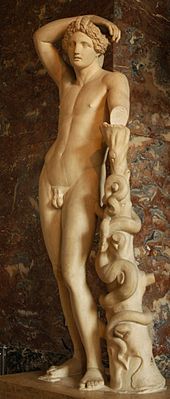
Ancient Greek myths took inspiration from
In
The surviving 2nd-century collection of
Modern interpretations
The genesis of modern understanding of Greek mythology is regarded by some scholars as a double reaction at the end of the eighteenth century against "the traditional attitude of Christian animosity", in which the Christian reinterpretation of myth as a "lie" or fable had been retained.[74] In Germany, by about 1795, there was a growing interest in Homer and Greek mythology. In Göttingen, Johann Matthias Gesner began to revive Greek studies, while his successor, Christian Gottlob Heyne, worked with Johann Joachim Winckelmann, and laid the foundations for mythological research both in Germany and elsewhere.[5]: 9 About 100 years later the interest for Greek mythology was still alive when Hermann Steuding published his book Griechische und römische Götter- und Heldensage in 1897.[75][76][77][78][79]
Comparative and psychoanalytic approaches
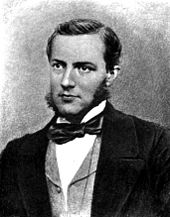
The development of comparative philology in the 19th century, together with ethnological discoveries in the 20th century, established the science of myth. Since the Romantics, all study of myth has been comparative. Wilhelm Mannhardt, James Frazer, and Stith Thompson employed the comparative approach to collect and classify the themes of folklore and mythology.[80] In 1871 Edward Burnett Tylor published his Primitive Culture, in which he applied the comparative method and tried to explain the origin and evolution of religion.[81][82]: 9 Tylor's procedure of drawing together material culture, ritual and myth of widely separated cultures influenced both Carl Jung and Joseph Campbell. Max Müller applied the new science of comparative mythology to the study of myth, in which he detected the distorted remains of Aryan nature worship. Bronisław Malinowski emphasized the ways myth fulfills common social functions. Claude Lévi-Strauss and other structuralists have compared the formal relations and patterns in myths throughout the world.[80]
Sigmund Freud introduced a transhistorical and biological conception of man and a view of myth as an expression of repressed ideas. Dream interpretation is the basis of Freudian myth interpretation and Freud's concept of dreamwork recognizes the importance of contextual relationships for the interpretation of any individual element in a dream. This suggestion would find an important point of rapprochement between the structuralist and psychoanalytic approaches to myth in Freud's thought.[83] Carl Jung extended the transhistorical, psychological approach with his theory of the "collective unconscious" and the archetypes (inherited "archaic" patterns), often encoded in myth, that arise out of it.[3] According to Jung, "myth-forming structural elements must be present in the unconscious psyche."[84] Comparing Jung's methodology with Joseph Campbell's theory, Robert A. Segal (1990) concludes that "to interpret a myth Campbell simply identifies the archetypes in it. An interpretation of the Odyssey, for example, would show how Odysseus's life conforms to a heroic pattern. Jung, by contrast, considers the identification of archetypes merely the first step in the interpretation of a myth."[85] Karl Kerényi, one of the founders of modern studies in Greek mythology, gave up his early views of myth, in order to apply Jung's theories of archetypes to Greek myth.[5]: 38
Origin theories
| Mythology |
|---|
It appears that the Mycenaean religion was the mother of the Greek religion[88] and its pantheon already included many divinities that can be found in classical Greece.[89] However, Greek mythology is generally seen as having heavy influence of Pre-Greek and Near Eastern cultures, and as such contains few important elements for the reconstruction of the Proto-Indo-European religion.[90] Consequently, Greek mythology received minimal scholarly attention in the context of Indo-European comparative mythology until the mid 2000s.[91]
Archaeology and mythography have revealed influence from Asia Minor and the Near East.
In addition to Indo-European and Near Eastern origins, some scholars have speculated on the debts of Greek mythology to the indigenous pre-Greek societies:
Motifs in Western art and literature
The widespread adoption of Christianity did not curb the popularity of the myths. With the rediscovery of classical antiquity in the Renaissance, the poetry of Ovid became a major influence on the imagination of poets, dramatists, musicians and artists.[3][97] From the early years of Renaissance, artists such as Leonardo da Vinci, Michelangelo, and Raphael, portrayed the Pagan subjects of Greek mythology alongside more conventional Christian themes.[3][97] Through the medium of Latin and the works of Ovid, Greek myth influenced medieval and Renaissance poets such as Petrarch, Boccaccio and Dante in Italy.[3]
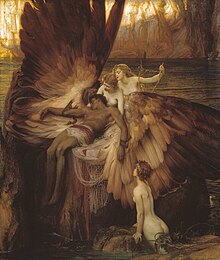
In Northern Europe, Greek mythology never took the same hold of the visual arts, but its effect was very obvious on literature.[98] The English imagination was fired by Greek mythology starting with Chaucer and John Milton and continuing through Shakespeare to Robert Bridges in the 20th century. Racine in France and Goethe in Germany revived Greek drama, reworking the ancient myths.[3][97] Although during the Enlightenment of the 18th century reaction against Greek myth spread throughout Europe, the myths continued to provide an important source of raw material for dramatists, including those who wrote the libretti for many of Handel's and Mozart's operas.[99]
By the end of the 18th century,
References
Notes
Citations
- Encyclopaedia The Helios. 1952.
- ^ Cartwirght, Mark. "Greek Mythology". World History Encyclopedia. Archived from the original on 18 April 2021. Retrieved 26 March 2018.
- ^ a b c d e f g h i j k l Adkins, A. W. H.; Pollard, John R. T. (2002) [1998]. "Greek Mythology". Encyclopædia Britannica.
- ISBN 978-0-271-01870-6.
- ^ ISBN 9780801846571.
- ^ Alms, Anthony. 2007. Theology, Trauerspiel, and the Conceptual Foundations of Early German Opera. City University of New York.
- ^ ISBN 978-0-415-18636-0.
- ^ ISBN 978-0-415-14754-5.
- ^ ISBN 978-0-313-28973-6.
- ISBN 978-960-14-0843-9.
- ISBN 978-0-19-280388-7.
- ^ Pasiphae Archived 15 May 2018 at the Wayback Machine, Encyclopedia: Greek Gods, Spirits, Monsters
- ISBN 0-253-32636-2
- ^ Homer, Iliad, 8. An epic poem about the Battle of Troy. 366–369
- ^ Cuthbertson, Gilbert (1975) Political Myth and Epic. Ann Arbor: Michigan State University Press.
- ^ ISBN 978-0-486-41107-1.
- ISBN 978-0-9714686-0-3.
- ISBN 978-0-252-06740-2.
- ^ ISBN 978-0-415-06135-3.
- ^ ISBN 978-0-631-15624-6.
- ^ Hesiod, Works and Days, 90–105 Archived 12 May 2015 at the Wayback Machine
- ^ Ovid, Metamorphoses, I, 89–162 Archived 23 October 2017 at the Wayback Machine
- ^ a b Hesiod, Theogony, 116–138
- ^ Hesiod, Theogony, 713–735
- ^ ISBN 978-0-600-02350-0.
- ^ Homeric Hymn to Hermes, 414–435 Archived 25 October 2008 at the Wayback Machine
- ^ ISBN 978-0-521-80108-9.
- ISBN 978-0-521-44667-9.
- ^ a b c Stoll, Heinrich Wilhelm. 1852. Handbook of the Religion and Mythology of the Greeks, translated by R. B. Paul. Francis & John Rivington.
- ^ Adkins, A. W. H.; Pollard, John R. T. (2 March 2020) [2002]. "Greek Religion". Encyclopædia Britannica.
- ^ J. Cashford, The Homeric Hymns, vii
- ISBN 978-0-8014-8048-5.
- ISBN 978-0-500-51615-7.
- ^ Homeric Hymn to Aphrodite, 75–109 Archived 12 September 2006 at the Wayback Machine
- ISBN 978-0-631-19602-0.
- ISBN 978-3-11-018266-8.
- ISBN 978-1-4051-0735-8.
- ISBN 978-0-7387-0096-0.
- ^ Nilsson, Martin P. 1940. "The Religion of Eleusis" in Greek Popular Religion Archived 1 December 2017 at the Wayback Machine. New York: Columbia University Press. p. 50 Archived 1 December 2017 at the Wayback Machine.
- ^ Homeric Hymn to Demeter, 255–274 Archived 16 June 2022 at the Wayback Machine
- ^ Allyn and Bacon. p. 30.
- ^ ISBN 978-0-415-04601-5.
- ^ Dupuis, C. F. The Origin of All Religious Worship. p. 86.
- ^ a b "Heracles". Encyclopædia Britannica. 6 February 2020 [1999].
- ISBN 978-0-521-85126-8. p. 1.
- ^ Herodotus, The Histories, I, 6–7 Archived 16 November 2017 at the Wayback Machine.
- ISBN 978-0-520-02389-5. p. 183.
- ^ Apollodorus, Library and Epitome, 1.9.16 Archived 17 September 2008 at the Wayback Machine.
- ^ Apollonius, Argonautica, I, 20ff Archived 12 May 2015 at the Wayback Machine.
- ^ Pindar, Pythian Odes, Pythian 4.1 Archived 17 September 2008 at the Wayback Machine.
- ^ a b "Argonaut". Encyclopædia Britannica. 2002.
- ^ ISBN 978-0-631-20102-1.
- ISBN 978-0-226-06454-3. p. 103.
- ^ Encyclopaedia The Helios. 1952.
- ^ a b c "Troy (Ancient City)". Encyclopædia Britannica. 25 April 2019 [1998].
- ISBN 978-1-149-40338-9. p. 355.
- ^ Kelly, Douglas. The Conspiracy of Allusion. p. 121.
- ^ ISBN 978-960-352-545-5. p. 37.
- ^ ISBN 978-0-19-285438-4. p. 80.
- ^
ISBN 9780226854342. Retrieved 14 November 2023.
Did the Greeks believe in their mythology? The answer is difficult, for 'believe' means so many things. Not everyone believed that Minos, after his death, continued being a judge in Hell or that Theseus fought the Minotaur, and they knew that poets 'lie' [...] [I]n the minds of the Greeks, Theseus had, nonetheless, existed. [...] Why did the Greeks go to the trouble of wishing to separate the wheat from the chaff in myth [...]? We see the extent of the problem when we realize that this attitude toward myth lasted for over two millennia.
- ^ Plato, Theaetetus, 176b Archived 8 March 2021 at the Wayback Machine
- ^ Plato, Apology, 28b-d Archived 8 March 2021 at the Wayback Machine
- ^ ISBN 978-0-521-45135-2.
- ^ "Euhemerus". Encyclopædia Britannica. 3 January 2020 [1998].
- ^ ISBN 978-0-8130-1256-8. p. 69.
- ^ ISBN 978-0-19-282511-7.
- ^ ISBN 978-1-139-49709-1.
- ^ Cicero, Tusculanae Disputationes, 1.11 Archived 15 October 2017 at the Wayback Machine
- ^ Cicero, De Divinatione, 2.81 Archived 10 October 2017 at the Wayback Machine
- ISBN 0-13-182622-0.
- ISBN 978-0-521-31682-8. p. 259.
- ISBN 978-81-206-0920-4. p. 38.
- ^ Sacred Texts, Orphic Hymns Archived 18 November 2017 at the Wayback Machine
- ^ Ackerman, Robert. 1991. Introduction to Jane Ellen Harrison's 'A Prolegomena to the Study of Greek Religion'. p. xv.
- . Retrieved 25 August 2023.
- ^ "OGND - results/titledata". swb.bsz-bw.de. Retrieved 25 August 2023.
- ^ "Katalog der Deutschen Nationalbibliothek". portal.dnb.de. Retrieved 25 August 2023.
- ^ "Theologische Literaturzeitung, 37 - OpenDigi". idb.ub.uni-tuebingen.de. Retrieved 5 September 2023.
- ^ Steuding, Hermann (1903). Greek and Roman Mythology & Heroic Legend, by Prof. H. Steuding. J.M. Dent & Company.
- ^ a b Buxton, Richard G. A.; Bolle, Kees W.; Smith, Jonathan Z. (2002). "myth". Encyclopædia Britannica.
- ISBN 978-1-55849-191-5. p. 16.
- ^ ISBN 978-90-279-7594-2.
- ISBN 978-0-8018-3864-4. p. 344.
- ^ Jung, Carl. The Psychology of the Child Archetype. p. 85.
- ^ Segal, Robert A. (1990). "The Romantic Appeal of Joseph Campbell." Christian Century (April 1990):332–5. Archived from the original on 7 January 2007.
- ^ H.I. Poleman, Review, 78–79
- ^ A. Winterbourne, When the Norns Have Spoken, 87
- C.H. Beck Verlag. Volume I, p. 339.
- ^ Paul, Adams John (10 January 2010). "Mycenaean Divinities". Northridge, CA: California State University. Archived from the original on 1 October 2018. Retrieved 25 September 2013.
- ^ Puhvel, Jaan. 1987. Comparative Mythology. Baltimore: Johns Hopkins University Press. p. 138, 143.
- Mallory, J.P., and Douglas Q. Adams. 2006. Oxford Introduction to Proto-Indo-European and the Proto-Indo-European World. London: Oxford University Press. p. 440.
- ^ L. Edmunds, Approaches to Greek Myth, 184
- ISBN 978-0-8014-2473-1. p. 64.
- ^ M. Reinhold, The Generation Gap in Antiquity, 349
- ^ Martin P. Nilsson (1927) The Minoan-Mycenaean Religion and Its Survival in Greek Religion
- ^ M. Wood, In Search of the Trojan War, 112
- ^ a b c L. Burn, Greek Myths, 75
- OCLC 912455670.
- ^ l. Burn, Greek Myths, 75
- ^ l. Burn, Greek Myths, 75–76
Primary sources (Greek and Roman)
- Aeschylus, The Persians. See original text in Perseus program Archived 17 September 2008 at the Wayback Machine.
- Aeschylus, Prometheus Bound. See original text in Perseus program Archived 2 May 2008 at the Wayback Machine.
- Apollodorus, Library and Epitome. See original text in Perseus program Archived 2 May 2008 at the Wayback Machine.
- Apollonius of Rhodes, Argonautica, Book I. See original text in Sacred Texts Archived 12 May 2015 at the Wayback Machine.
- Cicero, De Divinatione. See original text in the Latin Library Archived 10 October 2017 at the Wayback Machine.
- Cicero, Tusculanae resons. See original text in the Latin Library Archived 15 October 2017 at the Wayback Machine.
- Herodotus, The Histories, I. See original text in the Sacred Texts Archived 16 November 2017 at the Wayback Machine.
- Hesiod, Works and Days. Translated into English Archived 12 May 2015 at the Wayback Machine by Hugh G. Evelyn-White.
- Hesiod (1914). . Translated by Hugh Gerard Evelyn-White – via Wikisource.
- Homer, Iliad. See original text in Perseus program Archived 27 March 2008 at the Wayback Machine.
- Homeric Hymn to Aphrodite. Translated into English by Gregory Nagy.
- Homeric Hymn to Demeter. See original text in Perseus project Archived 11 February 2021 at the Wayback Machine.
- Homeric Hymn to Hermes. See the English translation in the Medieval and Classical Literature Library Archived 25 October 2008 at the Wayback Machine.
- Ovid, Metamorphoses. See original text in the Latin Library Archived 23 October 2017 at the Wayback Machine.
- Pausanias, Description of Greece See original text in Perseus program Archived 20 July 2021 at the Wayback Machine.
- Pindar, Pythian Odes, Pythian 4: For Arcesilas of Cyrene Chariot Race 462 BC. See original text in the Perseus program Archived 17 September 2008 at the Wayback Machine.
- Plato, Apology. See original text in Perseus program Archived 17 September 2008 at the Wayback Machine.
- Plato, Theaetetus. See original text in Perseus program Archived 29 March 2008 at the Wayback Machine.
Secondary sources
- Ackerman, Robert (1991). "Introduction". Prolegomena to the Study of Greek Religion by Jane Ellen Harrison (Reprint ed.). Princeton University Press. ISBN 978-0-691-01514-9.
- Albala Ken G; Johnson Claudia Durst; Johnson Vernon E. (2000). "Origin of Mythology". Understanding the Odyssey. Courier Dover Publications. ISBN 978-0-486-41107-1.
- Algra, Keimpe (1999). "The Beginnings of Cosmology". The Cambridge Companion to Early Greek Philosophy. Cambridge University Press. ISBN 978-0-521-44667-9.
- Allen, Douglas (1978). "Early Methological Approaches". Structure & Creativity in Religion: Hermeneutics in Mircea Eliade's Phenomenology and New Directions. Walter de Gruyter. ISBN 978-90-279-7594-2.
- "Argonaut". Encyclopædia Britannica. 2002.
- Betegh, Gábor (2004). "The Interpretation of the poet". The Derveni Papyrus. Cambridge University Press. ISBN 978-0-521-80108-9.
- Bonnefoy, Yves (1992). "Kinship Structures in Greek Heroic Dynasty". Greek and Egyptian Mythologies. University of Chicago Press. ISBN 978-0-226-06454-3.
- Bulfinch, Thomas (2003). "Greek Mythology and Homer". Bulfinch's Greek and Roman Mythology. Greenwood Press. ISBN 978-0-313-30881-9.
- Burkert, Walter (2002). "Prehistory and the Minoan Mycenaen Era". Greek Religion: Archaic and Classical (translated by John Raffan). Blackwell Publishing. ISBN 978-0-631-15624-6.
- Burn, Lucilla (1990). Greek Myths. University of Texas Press. ISBN 978-0-292-72748-9.
- Bushnell, Rebecca W. (2005). "Helicocentric Stoicism in the Saturnalia: The Egyptian Apollo". Medieval A Companion to Tragedy. Blackwell Publishing. ISBN 978-1-4051-0735-8.
- Chance, Jane (1994). "Helicocentric Stoicism in the Saturnalia: The Egyptian Apollo". Medieval Mythography. University Press of Florida. ISBN 978-0-8130-1256-8.
- Caldwell, Richard (1990). "The Psychoanalytic Interpretation of Greek Myth". Approaches to Greek Myth. ISBN 978-0-8018-3864-4.
- Calimach, Andrew (2002). "The Cultural Background". Lovers' Legends: The Gay Greek Myths. Haiduk Press. ISBN 978-0-9714686-0-3.
- Cartledge, Paul A. (2002). "Inventing the Past: History v. Myth". The Greeks. ISBN 978-0-19-280388-7.
- Cartledge, Paul A. (2004). The Spartans (translated in Greek). Livanis. ISBN 978-960-14-0843-9.
- Cashford, Jules (2003). "Introduction". The Homeric Hymns. Penguin Classics. ISBN 978-0-14-043782-9.
- Dowden, Ken (1992). "Myth and Mythology". The Uses of Greek Mythology. Routledge (UK). ISBN 978-0-415-06135-3.
- Dunlop, John (1842). "Romances of Chivalry". The History of Fiction. Carey and Hart. ISBN 978-1-149-40338-9.
- Edmunds, Lowell (1980). "Comparative Approaches". Approaches to Greek Myth. Johns Hopkins University Press. ISBN 978-0-8018-3864-4.
- "Euhemerus". Encyclopædia Britannica. 2002.
- Foley, John Miles (1999). "Homeric and South Slavic Epic". Homer's Traditional Art. ISBN 978-0-271-01870-6.
- Gale, Monica R. (1994). "The Cultural Background". Myth and Poetry in Lucretius. Cambridge University Press. ISBN 978-0-521-45135-2.
- "Greek Mythology". Encyclopædia Britannica. 2002.
- "Greek Religion". Encyclopædia Britannica. 2002.
- Griffin, Jasper (1986). "Greek Myth and Hesiod". The Oxford Illustrated History of Greece and the Hellenistic World edited by John Boardman, Jasper Griffin and Oswyn Murray. Oxford University Press. ISBN 978-0-19-285438-4.
- Grimal, Pierre (1986). "Argonauts". The Dictionary of Classical Mythology. Blackwell Publishing. ISBN 978-0-631-20102-1.
- Hacklin, Joseph (1994). "The Mythology of Persia". Asiatic Mythology. Asian Educational Services. ISBN 978-81-206-0920-4.
- Hanson, Victor Davis; Heath, John (1999). Who Killed Homer (translated in Greek by Rena Karakatsani). Kakos. ISBN 978-960-352-545-5.
- Hard, Robin (2003). "Sources of Greek Myth". The Routledge Handbook of Greek Mythology: based on H. J. Rose's "A Handbook of Greek mythology". Routledge (UK). ISBN 978-0-415-18636-0.
- "Heracles". Encyclopædia Britannica. 2002.
- Jung Carl Gustav, Kerényi Karl (2001). "Prolegomena". Essays on a Science of Mythology (Reprint ed.). Princeton University Press. ISBN 978-0-691-01756-3.
- Jung, C.J. (2002). "Troy in Latin and French Joseph of Exeter's "Ylias" and Benoît de Sainte-Maure's "Roman de Troie"". Science of Mythology. Routledge (UK). ISBN 978-0-415-26742-7.
- Kelly, Douglas (2003). "Sources of Greek Myth". An Outline of Greek and Roman Mythology. Douglas Kelly. ISBN 978-0-415-18636-0.
- Kelsey, Francis W. (1889). A Handbook of Greek Mythology. Allyn and Bacon.
- ISBN 978-0-520-02389-5.
- Kirk, Geoffrey Stephen (1974). The Nature of Greek Myths. Harmondsworth: Penguin. ISBN 978-0-14-021783-4.
- Klatt J. Mary, Brazouski Antoinette (1994). "Preface". Children's Books on Ancient Greek and Roman Mythology: An Annotated Bibliography. Greenwood Press. ISBN 978-0-313-28973-6.
- Lexicon Iconographicum Mythologiae Classicae, Artemis-Verlag, 1981–1999
- Miles, Geoffrey (1999). "The Myth-kitty". Classical Mythology in English Literature: A Critical Anthology. University of Illinois Press. ISBN 978-0-415-14754-5.
- Morris, Ian (2000). Archaeology As Cultural History. Blackwell Publishing. ISBN 978-0-631-19602-0.
- "myth". Encyclopædia Britannica. 2002.
- Nagy, Gregory (1992). "The Hellenization of the Indo-European Poetics". Greek Mythology and Poetics. ISBN 978-0-8014-8048-5.
- Nilsson, Martin P. (1940). "The Religion of Eleusis". Greek Popular Religion. Columbia University Press. Archived from the original on 1 December 2017. Retrieved 20 November 2006.
- North John A.; Beard Mary; Price Simon R.F. (1998). "The Religions of Imperial Rome". Classical Mythology in English Literature: A Critical Anthology. Cambridge University Press. ISBN 978-0-521-31682-8.
- Papadopoulou, Thalia (2005). "Introduction". Heracles and Euripidean Tragedy. Cambridge University Press. ISBN 978-0-521-85126-8.
- Percy, William Armostrong III (1999). "The Institutionalization of Pederasty". Pederasty and Pedagogy in Archaic Greece. Routledge (UK). ISBN 978-0-252-06740-2.
- Poleman, Horace I. (March 1943). "Review of "Ouranos-Varuna. Etude de mythologie comparee indo-europeenne by Georges Dumezil"". Journal of the American Oriental Society. 63 (1): 78–79. JSTOR 594160.
- Reinhold, Meyer (20 October 1970). "The Generation Gap in Antiquity". Proceedings of the American Philosophical Society. 114 (5): 347–65. JSTOR 985800.
- Rose, Herbert Jennings (1991). A Handbook of Greek Mythology. Routledge (UK). ISBN 978-0-415-04601-5.
- Segal, Robert A. (1991). "A Greek Eternal Child". Myth and the Polis edited by Dora Carlisky Pozzi, John Moore Wickersham. Cornell University Press. ISBN 978-0-8014-2473-1.
- Segal, Robert A. (4 April 1990). "The Romantic Appeal of Joseph Campbell". Christian Century. Archived from the original on 7 January 2007.
- Segal, Robert A. (1999). "Jung on Mythology". Theorizing about Myth. Univ of Massachusetts Press. ISBN 978-1-55849-191-5.
- Stoll, Heinrich Wilhelm (translated by R. B. Paul) (1852). Handbook of the religion and mythology of the Greeks. Francis and John Rivington.
- Trobe, Kala (2001). "Dionysus". Invoke the Gods. Llewellyn Worldwide. ISBN 978-0-7387-0096-0.
- "Trojan War". Encyclopaedia The Helios. 1952.
- "Troy". Encyclopædia Britannica. 2002.
- "Volume: Hellas, Article: Greek Mythology". Encyclopaedia The Helios. 1952.
- Walsh, Patrick Gerald (1998). "Liberating Appearance in Mythic Content". The Nature of the Gods. Oxford University Press. ISBN 978-0-19-282511-7.
- Weaver, John B. (1998). "Introduction". The Plots of Epiphany. Walter de Gruyter. ISBN 978-3-11-018266-8.
- Winterbourne, Anthony (2004). "Spinning and Weaving Fate". When the Norns Have Spoken. ISBN 978-0-8386-4048-7.
- Wood, Michael (1998). "The Coming of the Greeks". In Search of the Trojan War. University of California Press. ISBN 978-0-520-21599-3.
Further reading
- ISBN 978-0-8018-4410-2. Archivedfrom the original on 30 May 2023. Retrieved 6 November 2021.
- ISBN 978-0-14-017199-0.
- ISBN 978-0-316-34151-6.
- Kerenyi, Karl (1980) [1951]. The Gods of the Greeks (Reissue ed.). Thames & Hudson. ISBN 978-0-500-27048-6.
- Kerenyi, Karl (1978) [1959]. The Heroes of the Greeks (Reissue ed.). Thames & Hudson. ISBN 978-0-500-27049-3.
- Luchte, James (2011). Early Greek Thought: Before the Dawn. Bloomsbury. ISBN 978-0-567-35331-3.
- Morford M.P.O., Lenardon L.J. (2006). Classical Mythology. Oxford University Press. ISBN 978-0-19-530805-1.
- ISBN 978-0-448-00848-6.
- Pinsent, John (1991). Myths and Legends of Ancient Greece. Library of the World's Myths and Legends. Peter Bedrick Books. ISBN 978-0-87226-250-8.
- ISBN 978-0-13-606171-7.
- Powell, Barry (2001). A Short Introduction to Classical Myth. Prentice-Hall. ISBN 978-0-13-025839-7.
- Ruck Carl, Staples Blaise Daniel (1994). The World of Classical Myth. Carolina Academic Press. ISBN 978-0-89089-575-7.
- Smith, William (1870), Dictionary of Greek and Roman Biography and Mythology.
- ISBN 978-0-226-85434-2.
- Woodward, Roger D., ed. (2007). The Cambridge Companion to Greek Mythology. Cambridge; New York: Cambridge University Press. ISBN 978-0-521-84520-5.
External links
 Media related to Greek mythology at Wikimedia Commons
Media related to Greek mythology at Wikimedia Commons- Greek Myths on In Our Time at the BBC
- Library of Classical Mythology Texts translations of works of classical literature
- LIMC-France provides databases dedicated to Graeco-Roman mythology and its iconography.
- Martin P. Nilsson, The Mycenaean Origin of Greek Mythology, on Google books
- Greek mythology, the age of gods, myths and heroes, Hellenism.Net
